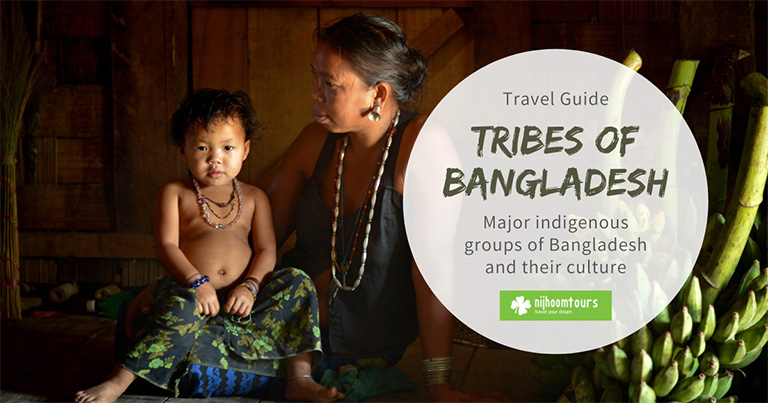
Bangladesh has many tribal people, the majority of whom live in the Chittagong hill tracts area. The life of the tribal people is extremely fascinating. The majority of them are Buddhists, and the rest are Hindus, Christians, and Animists. Despite the bondage of religion, elements of primitiveness are strongly displayed in their rites, rituals, and everyday life. The tribal families are matriarchal. The women-folk are more hard-working than males and they are the main productive force.
The tribal people are extremely self-reliant. They grow their own food, their girls weave their own clothes, and generally speaking, they live a simple life. Each tribe has its own dialect, distinctive dress, and rites and rituals. The common feature is their way of life, which still speaks of their main occupation. Some of them take pride in hunting with bows and arrows. Tribal women are very skillful in making beautiful handicrafts. Tribal people are generally peace-loving, honest, and hospitable. They usually greet a tourist with a smile.
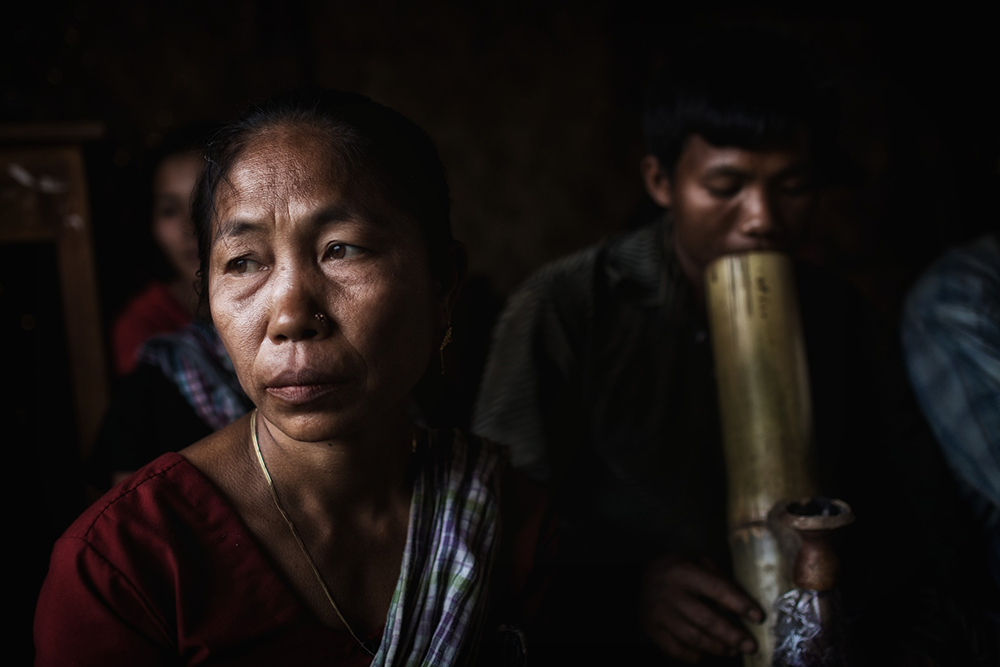
A Chakma lady in Khagrachhori
Chakma Tribe
The Chakma are the largest ethnic group in Bangladesh. According to the Census of 1991, the total number of Chakma in the CHT was 239,417. In addition, an estimated 150,000 Chakma live scattered about in the states of Tripura, Mizoram, Assam, and Arunachal Pradesh in India. A small number of Chakma also live in Cox’s Bazar district and in Myanmar (Burma).
The Chakma language belongs to the Indo-European family of languages and has close links with Pali, Assamese, and Bengali. The Chakma have their own script in which their ancient religious literature is preserved in palm leaves. The script has similarities with Mon Khmer and Burmese. Although many elderly Chakma still signs their names in the Chakma script, most Chakma youths no longer use the script. At school, Chakma children study in Bengali and English. The Chakma has perhaps proved to be the most adaptive and innovative of all the indigenous people of Bangladesh. By nature, most Chakma is down-to-earth and socially shy, but nevertheless romantic, although they will seldom admit it.
The head of Chakma society is the Chakma Chief who is descended from the general who led the resistance movement against the British East India Company’s forces in the 1770s. The Chakma have been followers of Gautama Buddha for centuries, but the Chakma brand of Buddhism always had room for indigenous gods and spirits, including some from the Hindu pantheon. Today, the Chakma are almost 100% Theravada Buddhist.
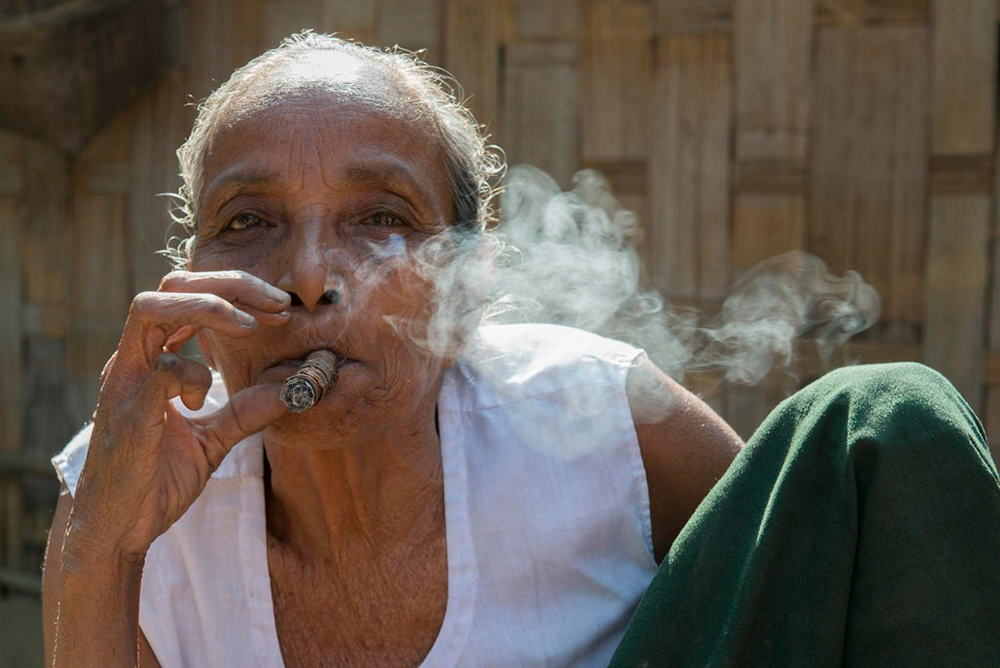
A Marma lady smoking churut
Marma Tribe
Marma is the 2nd largest indigenous ethnic group in Bangladesh. The 1991 Census puts the total number of Marma in CHT as 142,334. They have been Theravadan Buddhists, like the Burmese, Thai, and Srilankan, for many centuries. The Marma in the southern CHT, including all of Bandarban, traditionally owe loyalty to the Bohmong Chief, Bohmongri, who traces his lineage from Burmese generals.
The Marma have their own script and speak a language that is almost identical to that of the Rakhine or Rakhaing of Cox’s Bazar and Patuakhali districts in Bangladesh and Arakan state in Myanmar. The Marma language is soft and poetic and even people who do not understand Marma love to hear Marma songs. As with the Tripura and other people speaking a Tibeto-Burman tongue, the Marma start out with a disadvantage with the medium of instruction in schools being in the Bengali language. The introduction of primary education in the Marma language is believed to be a necessary step for the progress of education among the Marma. They have a beautiful language that deserves official recognition.
The Marmas are great lovers of music and drama. Before the advent of cinema and television, throngs of Marma youth in their best attire would pass the better part of a night watching folk dances and operatic performances. The Marmas are very fond of fairs. They have the particular knack of converting even their religious festivals into occasions of fun and gaiety. Traditionally, both men and women are fond of smoking pipes and cigars, all locally made. Rice beer or distilled rice spirits are very popular among men.
Among the Marma, there are both swidden agriculturists and sedentary rice farmers. Many Marma is traders, service-people, and professionals such as doctors, engineers, etc. Of the indigenous peoples of Bangladesh, Marma usually makes the best traders although the Chakma are also trying hard to become retail traders.
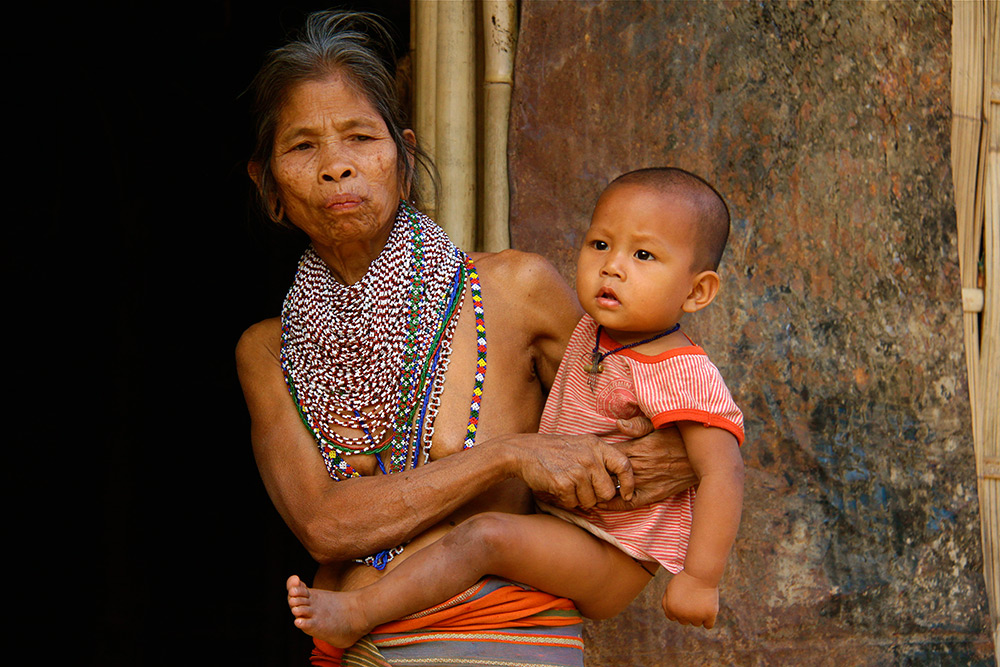
A Tripura family in Chittagong Hill-Tract
Tripura Tribe
According to the Census of 1991, the total number of Tripura in CHT was 61,129 out of which more than three quarters lived in the Khagrachari district alone. There are more than half a million Tripura in the Tripura state of India. A very small number of Tripura also live in the Bangladeshi districts of Chittagong, Comilla, and Noakhali.
The Tripura have about 36 sub-groups or dafas, the most well-known of which are the Fatung, Jamatia, Naitong, Noatia, Ryang, and Usui. The Tripura language belongs to the Bodo branch of the Tibeto-Burman family of languages. Although many Tripura follows their own gods, they also venerate such Hindu gods and goddesses as Lakshmi, Ganga, Saraswati, Kali, and Shiva. The Tripura were traditionally swidden cultivators although they have now diversified into many occupations. Tripura have many university graduates nowadays, but their language is so different from Bengali that they face disadvantages in studying in Bengali from their earliest years. The introduction of primary education in the Tripura language will most likely lead to a vast improvement in the rate of literacy of the Tripura.

Tanchangya ladies in Chittagong Hill-Tracts area
Tanchangya Tribe
The Tanchangya number 19,221 in the CHT according to the Census 1991. Most of the Tanchangya live on the borders between the Rangamati and Chittagong districts between the borders of the Rangamati and Bandarban districts. A small number of Tanchangya also live in Cox’s Bazar district. In Arakanese, the word “Taung” or “Tong” means hill and “Taungya” means hilltop swidden cultivation known locally as Jum. The word Tanchangya or Tongtongya is believed to mean hill swidden farmer.
The Tanchangya are traditionally Buddhist. Despite the fact that the Tanchangya are known traditionally to be swidden farmers, they were, in fact, one of the first of the CHT people to take up wet-rice cultivation by the plow in lieu of swidden cultivation. Today there are many Tanchangya graduates, both men, and women, holding private and government jobs.
The Tanchangya are known to be very romantic and artistic. It is said that in many cases the Tanchangya groom is younger than the bride. This was common until about a few decades ago. The Tanchangya are very musical. Love and romance are therefore never far away. Traditionally attired Tanchangya women will always wear her turban, which Chakma women used until a generation or two ago. The pattern on the border or her homespun skirt will usually be far more intricate than the Chakma skirt.
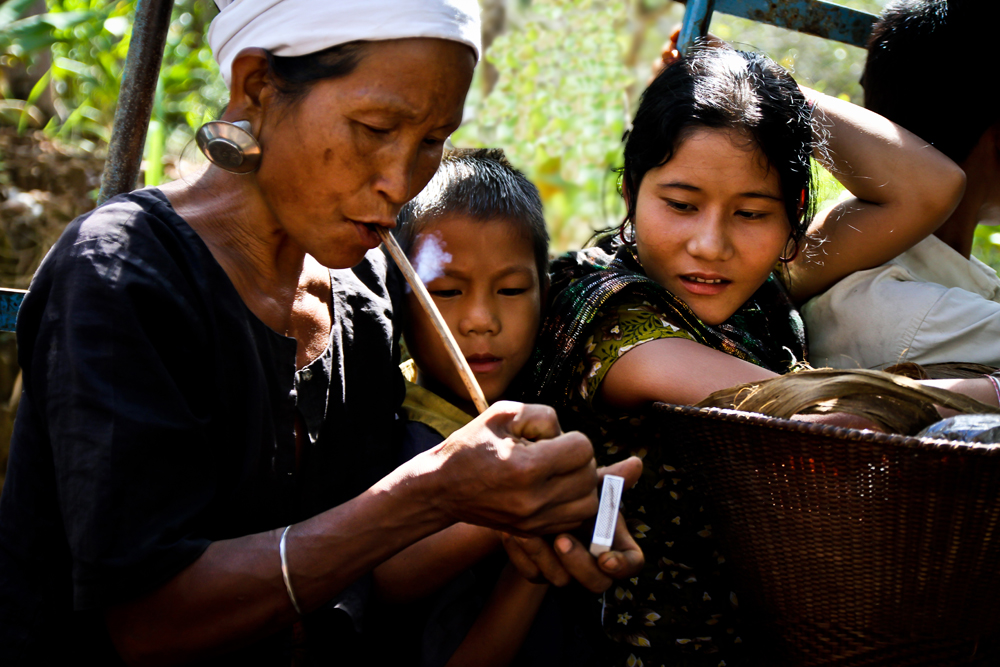
A Khumi family at Bandarban
Khumi Tribe
The Khumis maintain that in their Khumi language Kha means man and mi mean the best race. They are, therefore “Khumis” i.e. the best human race. Others tell us that in the Arakanese language “Khe” means “dog” and “mi” is race. The Khumis, therefore, is the dog race. A dog is a favorite item of food of Khumis, so they might have derived this name from this. According to their oral tradition humankind owes its creation to a dog. Dog was the first creation, and it had saved humans from total annihilation, they accordingly pay homage to it.
The Khumis claim to be Buddhists, but their beliefs and religious rites are mostly animists. Their chief god is Pathian. They also pay homage to “Nadog” the household deity, and “Bogley” the water deity. They are divided into “wife-giving” and “wife-taking” clans. The eldest son inherits all the property. They have an oral language that belongs to the southern branch of the Kukish section. In 1869 their population was 2,000.
The Khumis came to the hills of Chittagong from the hills of Arakan and Akyab in the seventeenth century. They live on the ridges of hills and build their houses on tree-tops. Their villages are surrounded by bamboo walls. They were a ferocious race that was mostly engaged in warfare. They are renowned for their loyalty to their chiefs. They owed their allegiance to the Marma Bohmang chief and paid a yearly tribute to him through their village headman. They take the oath of loyalty by touching the blood of a goat, which they’ve killed with a sharp weapon; they vow that a similar fate would befall them if they break the oath of loyalty.
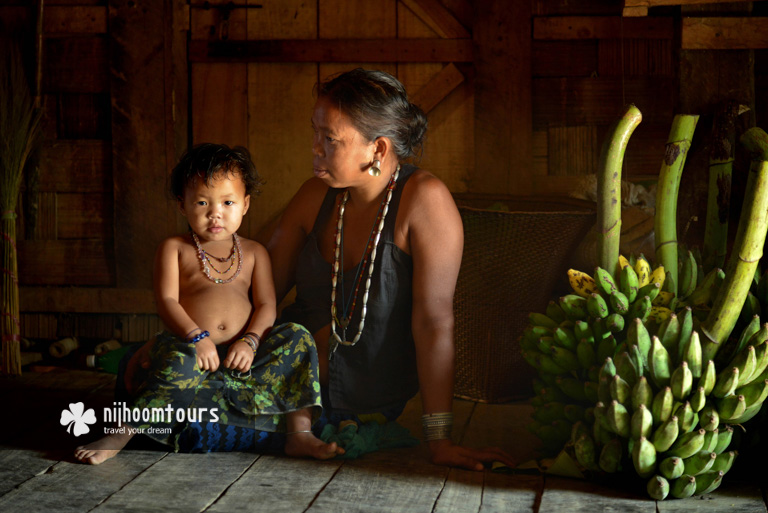
A Mro family in Chittagong Hill-Tract
Mro Tribe
In 1869 the Mro population was 1,500. They had no chief of their own and owed their allegiance to the Marma Bohmang chief of Bandarban. Each village had a chief who collected tributes from each head of the family for the Bohmang chief. The village chief’s position was hereditary. Mros are animists. Their creator is “Turai”. They have two other gods: “Oreng” and “Sungtiang”. They do not have any priesthood or religious books.
They believe that a bull that was sent by God Turai to carry the religious book for them had eaten up the book on the way. They, therefore, hold a special ceremony called “Nasyat pa” or “Kumlang” in which a bull is ceremoniously killed. They have an oral dialect that belongs to the Tibeto-Burmese linguistic family.
Lushai Tribe
The Lushai migrated into Chittagong hills from the Lushai hills of India some 150 years ago. Before the British conquest of the Lushai hills in 1892, the Lushais were extremely ferocious. They choose mountain tops as their abodes. The entrance to a village was heavily guarded. They are animists. “Pathian” is their chief god; he does no harm to people.
The Lushais are divided into different sects. It is a patriarchal society. The youngest son inherits all the property of the father. They neither burn nor bury their dead. The body is clad in beautiful clothes and placed in a sitting position inside a bamboo cage. A fire is lit beside the body for a period of three months. After this, the bones are removed and then buried. They have a language of their own known as “Lushai” or “Dolne”. Their language can be written in Latin script. During the British administration, missionaries were active among them; as a result, most of them took Christianity.
Khiang Tribe
In 1869 the Khiangs were a small group of people. Their social organization was similar to those of the Mros and Khumis. They owed their allegiance to chiefs in Burma. The Khiangs call themselves “Hyou”. They believe that some 200 years ago their chief sought refuge from war in Burma in the hills of Chittagong. The chief was accompanied by his younger wife who was pregnant. But he left behind this wife and some soldiers and went back to Burma. The Khiangs believe that they are descendants of those soldiers left behind in the CHT. They have no sub-castes or sects. They are Buddhists but they also pay homage to “Nada Ga” (household deity) and “Bogley” (water deity). Their language belongs to the Kuki-Chin group.
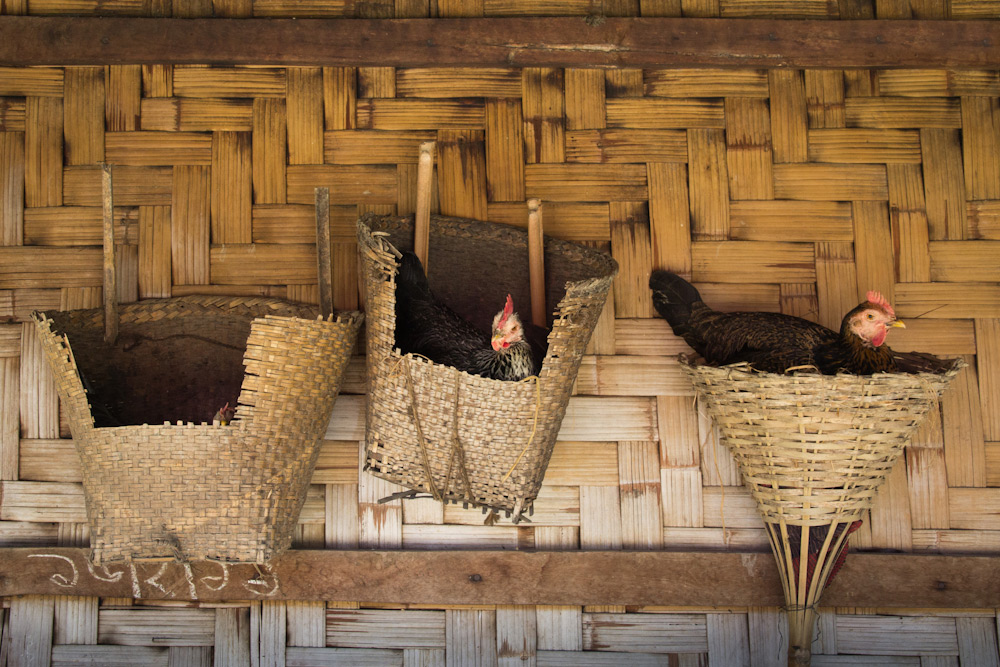
Chickens on a Bawm village at Bandarban
Bawm & Pankhu Tribe
The Bawm & Pankhu groups were offshoots of two brothers who belonged to a Lushai group. Their population in 1869 was about 3,000. They owed their allegiance to the Bohmang chief and paid tribute to him through their elected headman. The Bawms and Pankhus believe that they are descendants of the “Shan” nation of Burma. Formerly they were ferocious people who built their houses on mountain tops. Their villages were very heavily armed and guarded. They lost their military skills after their annexation by the British.
They were animists. Their main gods were “Pathian” and “khozing”. But due to missionary activities due to the British period, most of them took to Christianity. Their language has a strong resemblance to Lushai. It belongs to the “Kuki-Chin” group. One can differentiate between the Pankhus and Bawms by their hairstyles. Both men and women of the Bawms tie up their hair at the center of the head. The Pankhus, on the other hand, tie up their hair at the back of their head.

Kids on a Chak village
Chak Tribe
The Chak is considered to be a sub-group of Chakma. But Loffler maintains that the Saks living in Arakan and the Chaks in CHT descended from the same people as the Chakmas. The Chaks call themselves “Asak”, the Sak population in Arakan also calls itself “Asak”. Their language resembles Kadu which is spoken in Myitkhyina district of northern Myanmar, and also Andro and Sengmai languages of Manipur district in India. The Chaks are divided into two sects: Ando and Ngarek. They are Buddhists.
Have you ever visited the villages of different tribal groups in Bangladesh? How fascinating have you found their lifestyle? Which one is your favorite tribal group in Bangladesh and why? Have I missed something here? Share your thoughts and experience with us in the comments.
Check out our 1-28 days Bangladesh tour packages and 3-8 days Sundarban Tour Packages in Bangladesh to visit Bangladesh with comfort.
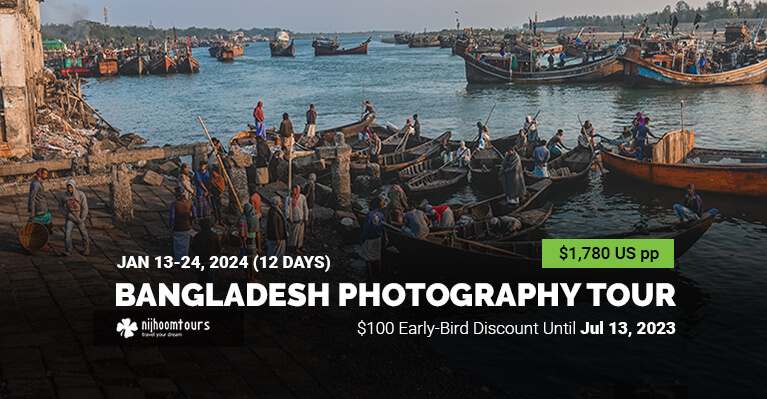
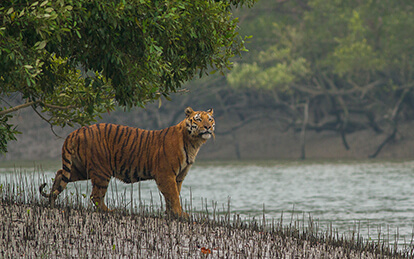
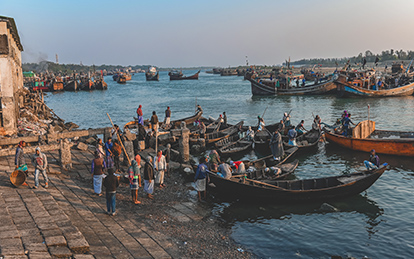
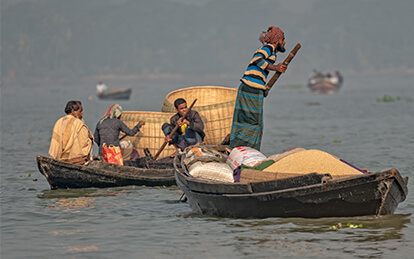
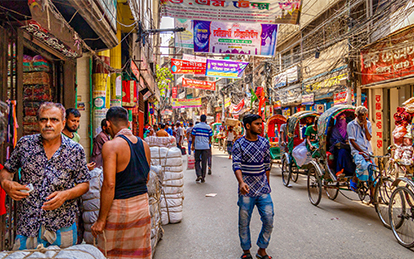
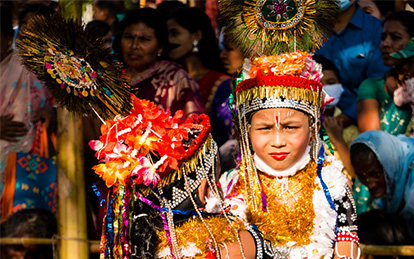
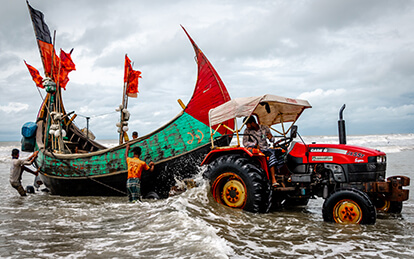
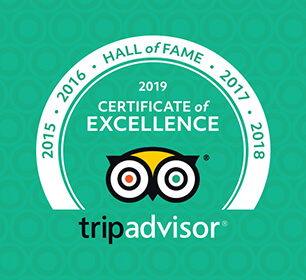
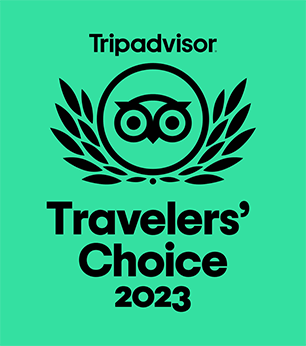
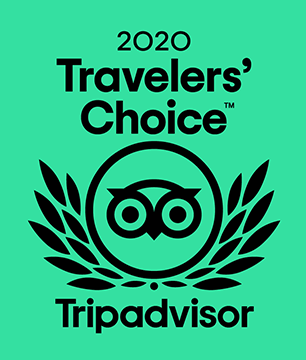
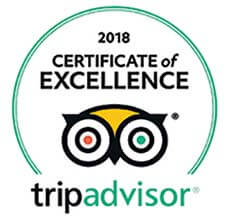
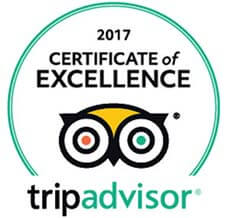
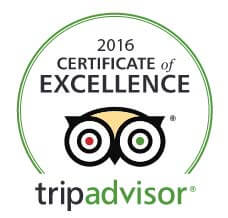
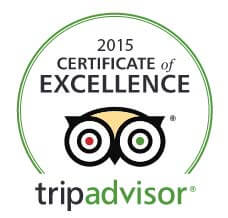
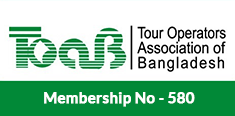


In 1657 was about 752 belived in Bangladesh came from Tibet .and started lived in Bangladeshes bodo kochari.and worked agreecultur .its now population 3 lac somtin and belived now other country
India 1.Assam 13.lac
2.Magaloy 2.5 lac
3.Nagaland 1.3 lac
4.Tripura 50/50
5.west Bengol 1.5lalc
Nepal 1.Katmandu 1.2 lac